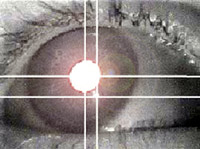
Signed languages exhibit characteristics found in all human languages, but at the same time they include characteristics that are clearly shaped by the visual-spatial modality. One of these properties is the use of eye gaze to mark linguistic contrasts. This project uses head-mounted eye-tracking technology to address the following questions:
- What role does eye gaze play in the grammar of American Sign Language (ASL)?
- How is ASL grammar learned as a second language by hearing people?
- What are the linguistic and cognitive factors that cause shifts in eye gaze during ASL perception?
- How do the linguistic and social functions of eye gaze interact?
Funding
This research was supported by the National Science Foundation Linguistics Program (BCS 0517994).
Recent Publications
- Thompson, R., Emmorey, K., Kluender, R., & Langdon, C. (2013). The eyes don’t point: Understanding language universals through person marking in American Sign Language. Lingua, 137, 219-229. Click to request PDF
- Thompson, R., Emmorey, K., & Kluender, R. (2009). Learning to look: The acquisition of eye gaze agreement during the production of ASL verbs. Bilingualism: Language and Cognition, 12(4), 393-409. Click to request PDF
- Emmorey, K., Thompson, R., & Colvin, R. (2009). Eye gaze during comprehension of American Sign Language by native and beginning signers. Journal of Deaf Studies & Deaf Education, 14(2), 237-243.
- Thompson, R.L., Langdon, C., & Emmorey, K. (2009). Understanding the linguistic functions of eyegaze in American Sign Language. Paper presented at the CUNY Conference on Human Sentence Processing, March, 2009, Davis, CA. Click to request PDF
- Thompson, R., & Emmorey, K. (2006). The relationship between eye gaze and pronouns in American Sign Language. Theoretical Issues in Sign Language Research 9, December, Florianópolis, Brazil.
- Thompson, R., Emmorey, K., & Kluender, R. (2006). The relationship between eye gaze and agreement in American Sign Language: An eye-tracking study. Natural Language and Linguistic Theory, 24, 571-604. Click to request PDF

